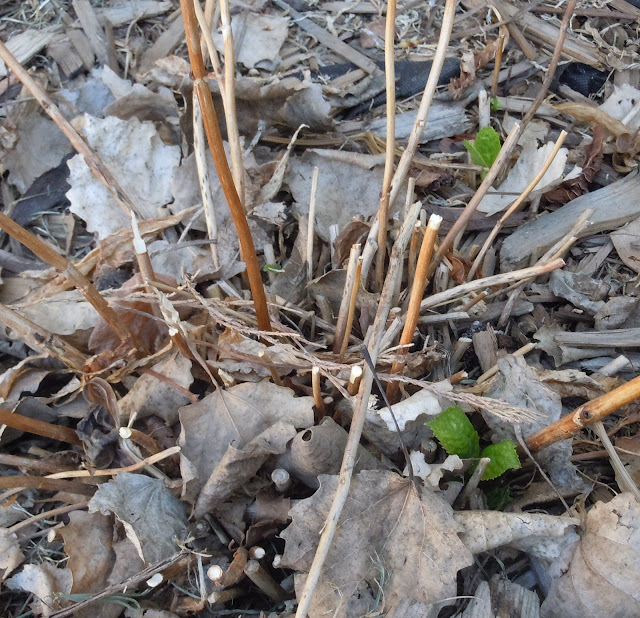The Gold winner at the Chelsea Flower Show 2012, "Welcome to Yorkshire" artisan garden. For more photos of the winners of this year's Chelsea Flower Show see:
http://www.telegraph.co.uk/gardening/chelseaflowershow/9282127/Chelsea-Flower-Show-2012-The-winners-in-pictures.html
27 May 2012
26 May 2012
Cedar Apple Rust
Cedar Apple Rust has been spotted in the Edmonton and St. Albert region of the province.
Cedar Apple Rust is a fungal disease that grows to look like the mass in the photo above. It may look like orange gobs as it grows, but when first starting it appears as orange coloured masses on branches, growing to gobs (galls), and cone-like masses. Junipers and cedars are hosts and while the fungal disease does little to these evergreens; when it spreads to rosaceous plants, ie. hawthorns, apples and mountain ash; the results can be extensive damage. The fungus spreads through the air, little spores leaving the host and affecting susceptible trees previously mentioned. On these trees, the hawthorns, apples and mountain ash, small orange spots appear on the leaves. These spread, grow larger and result in loss of foliage and deformed fruit.
 |
| Clemson University - USDA Cooperative Extension Slide Series, www.ipmimages.org |
The best method of prevention is to prune out any orange masses on junipers and cedars immediately to prevent it spreading to susceptible species of trees. There is no chemical control at this time, though it is recommended to spray Copper Bordeaux Spray on the rosaceous trees on your property as a preventative measure should you spot this rust on host plants. This offers a little protection, but is not a means of eradicating the fungus. The best method is prevention, cut it out and destroy.
To find out more about Cedar Apple Rust, visit Kansas State University for their PDF document on Juniper Diseases.
21 May 2012
19 May 2012
Solar Eclipse This Sunday
This Sunday, May 20, 2012, an infrequent event known as an annular solar eclipse - from the "annulus", a Latin word meaning "little ring" - and, weather permitting, will be best viewed in Asia, the Pacific region and some areas of Western North America. When it peaks, as the moon comes directly between the sun and earth, it will block about 94 percent of the sun.
Not visible on the east coast, as the sun will have set prior to this event, some parts of the United States and Canada will see a partial solar eclipse. This will take place late afternoon, translating to 6 pm May 20th in Edmonton and Calgary, and May 21st for those observing in Asia.
Space.com offers a http://www.space.com/15620-solar-eclipse-may20-skywatching-tips.html">Guide to Viewing on their site, with an in-depth look at what happens during an annular solar eclipse with warnings to viewers. The video embedded below is just the tease to entice you to make it to your local space and science centre to take part in the viewing of the annular solar eclipse.
18 May 2012
17 May 2012
Life in the back garden!
Above, the one and only tulip is flowering.
The PJM Rhododendron has new growth and flower buds.
This peony doubled in size in one day!!
Ah, there you are! Endless Summer Hydrangea died right back this winter. Here she is making her way up and out! Welcome!
One Evening Scented Stock seedling (an annual) came up from last year's planting. I love this Matthiola!
The fragrance is heavenly!
The delphinium is growing by leaps and bounds. I better get out and dust it to prevent delphinium worm problems!
One clematis, east side of the fence, is showing signs of life.
Forsythia is blooming, somewhat.
Gold Barberry, Summer Wine Ninebark, cedars, and a juniper fill this corner.
A view of the pond with topiaries, maple, and spirea in the foreground.
A view through the branches of Amur Maple.
Above and below, Three-flowered Maple.
A planting of reeds in the pond.
Three-flowered Maple to the left, Tolleson's Weeping Juniper in the background, and Mint Julip Juniper in the front.
This just goes to show how resilient the European Mountain Ash is. This seedling was left in a pot over winter, just a six inch pot, and it is growing! Talk about tough. (zone 3 here)
A close-up on Northern Gold Forsythia.
Teddy in the garden, above and below.
Trost Dwarf Birch is leafing out, above.
Young's Twisted Weeping Birch above and hostas below.
My son's car floor matts are drying on the deck stairs above. Funny, I didn't notice them there when I took the picture, just when I transferred the photos to the computer!
Oh, well. Utilizing every space is practical, if not aesthetically pleasing.
Shadows in the garden.
Bridal Wreath Spirea, aka Renaissance Spirea, above and below. These photos were taken Mother's Day.
Columbine above and Jackmanii Clematis (if you look close you can see a couple shoots) below, with iris in front.
My Mother's Day roses from my husband. XOXO
Taken yesterday, the same spirea (Bridal Wreath) now blooming her heart out!
The tulip has faded from butter yellow to white but is still very pretty.
What's growing in your garden?
Once again linking up with Tootsie for Fertilizer/Flaunt Your Flowers Friday. You have to see the creative ingenuity she puts in her garden! Be sure to check out our other garden pals as they flaunt their gardens too!
Subscribe to:
Posts (Atom)
















































